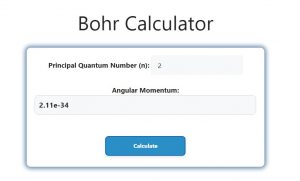About Bohr Calculator (Formula)
The Bohr Calculator is a vital tool for students and professionals studying atomic physics and quantum mechanics. Named after the renowned physicist Niels Bohr, this calculator helps in determining the angular momentum of an electron in a hydrogen atom based on Bohr’s model. According to this model, electrons orbit the nucleus at specific energy levels, and the Bohr Calculator enables users to compute the angular momentum associated with these orbits. Understanding angular momentum is crucial for grasping atomic structure and behavior, making this calculator an essential resource in educational settings.
Formula
The formula for calculating angular momentum is: Angular Momentum (L) = (n * h) / (2 * π), where “n” represents the principal quantum number, “h” is Planck’s constant, and “π” is the mathematical constant pi.
How to Use
Using the Bohr Calculator is straightforward. Follow these steps:
- Identify the Principal Quantum Number (n): Determine the energy level of the electron. For example, the first energy level corresponds to n = 1.
- Input Planck’s Constant (h): Planck’s constant is approximately 6.626 x 10^-34 Js. This value is often pre-set in the calculator.
- Calculate Angular Momentum: Enter the values and click the calculate button to find the angular momentum.
Example
Let’s consider an example for better understanding.
Suppose you want to calculate the angular momentum of an electron in the second energy level of a hydrogen atom.
- Identify Values:
- n = 2
- h = 6.626 x 10^-34 Js
- Apply the Formula:
- L = (n * h) / (2 * π)
- L = (2 * 6.626 x 10^-34) / (2 * 3.14159)
- L ≈ 6.2832 x 10^-34 Js
In this case, the angular momentum of the electron in the second energy level is approximately 6.2832 x 10^-34 Js.

FAQs
- What is the Bohr model?
- The Bohr model describes the structure of atoms, particularly hydrogen, as having electrons in fixed orbits around the nucleus.
- What is angular momentum in the context of atomic physics?
- Angular momentum refers to the rotational momentum of an electron moving in its orbit around the nucleus.
- Why is the principal quantum number (n) important?
- The principal quantum number determines the energy level of an electron in an atom, influencing its angular momentum.
- What is Planck’s constant?
- Planck’s constant is a fundamental constant in quantum mechanics, used to describe the sizes of quanta. It is approximately 6.626 x 10^-34 Js.
- Can the Bohr model be used for all atoms?
- The Bohr model is primarily applicable to hydrogen-like atoms. It does not accurately describe multi-electron atoms due to electron-electron interactions.
- How does the Bohr Calculator help in learning atomic physics?
- The Bohr Calculator simplifies complex calculations, helping students visualize and understand the relationship between quantum numbers and angular momentum.
- Is angular momentum quantized in the Bohr model?
- Yes, according to the Bohr model, angular momentum is quantized and can only take specific discrete values based on the principal quantum number.
- How do changes in energy levels affect angular momentum?
- As the principal quantum number (n) increases, the angular momentum of the electron also increases, reflecting its greater distance from the nucleus.
- What are the limitations of the Bohr model?
- The Bohr model does not account for phenomena like electron spin and does not accurately predict spectra for multi-electron atoms.
- How accurate is the Bohr model?
- While the Bohr model provides a good approximation for hydrogen, it is less accurate for more complex atoms, requiring more sophisticated quantum mechanical models.
- Can the Bohr Calculator be used for other elements?
- The calculator is mainly intended for hydrogen and hydrogen-like ions. For other elements, different models may be needed.
- What is the significance of π in the formula?
- π is a mathematical constant that relates to the circular nature of electron orbits in the Bohr model.
- How can I verify the results from the Bohr Calculator?
- You can verify results by comparing them with theoretical predictions or using alternative methods to calculate angular momentum.
- What role does the Bohr model play in modern physics?
- The Bohr model laid the groundwork for quantum mechanics and the development of more advanced atomic theories.
- Is the Bohr model still relevant today?
- Yes, while it has limitations, the Bohr model is still used for introductory physics education and understanding basic atomic structure.
- What other calculations can be performed related to the Bohr model?
- Users can calculate energy levels, radii of electron orbits, and spectral lines using similar principles from the Bohr model.
- How does temperature affect electron energy levels?
- At higher temperatures, electrons may gain energy, potentially moving to higher energy levels or becoming ionized.
- What is the relationship between angular momentum and electron orbits?
- Angular momentum quantifies the motion of electrons in their orbits, impacting their stability and energy levels.
- Can the Bohr Calculator be integrated into other software?
- Depending on its design, some Bohr Calculators may offer APIs for integration into educational platforms or software tools.
- How do I interpret the results from the Bohr Calculator?
- The results provide insight into the angular momentum of electrons, helping you understand their behavior in atomic structures.
Conclusion
The Bohr Calculator is a powerful tool for anyone studying atomic physics, providing a straightforward means of calculating angular momentum based on the principles of the Bohr model. By utilizing this calculator, students and researchers can deepen their understanding of atomic structure and the behavior of electrons. As foundational as it is, the Bohr model serves as a stepping stone toward more complex theories in quantum mechanics, making the Bohr Calculator an essential resource in the field of physics.